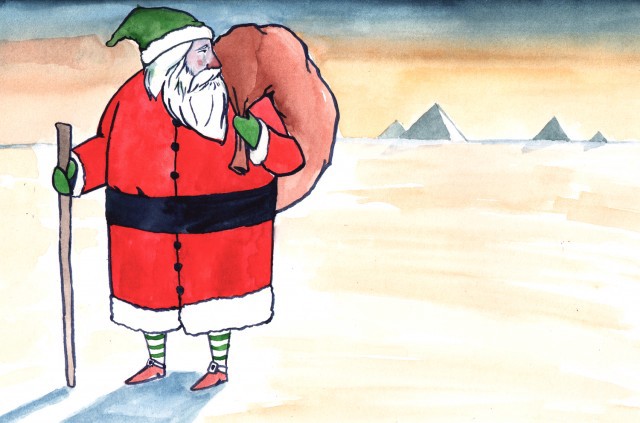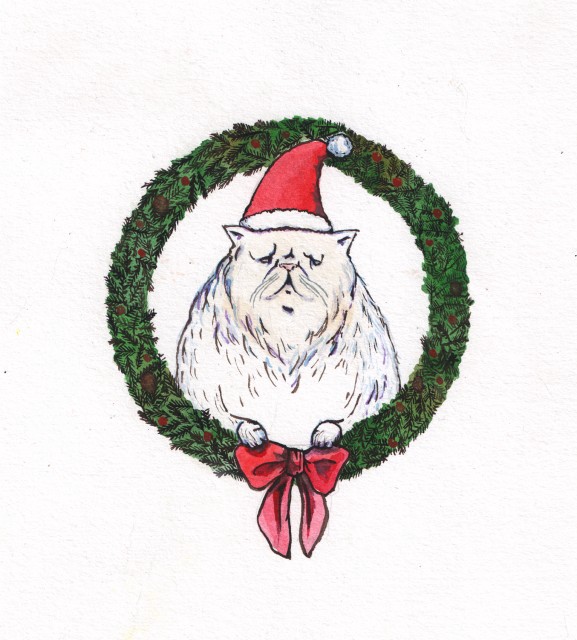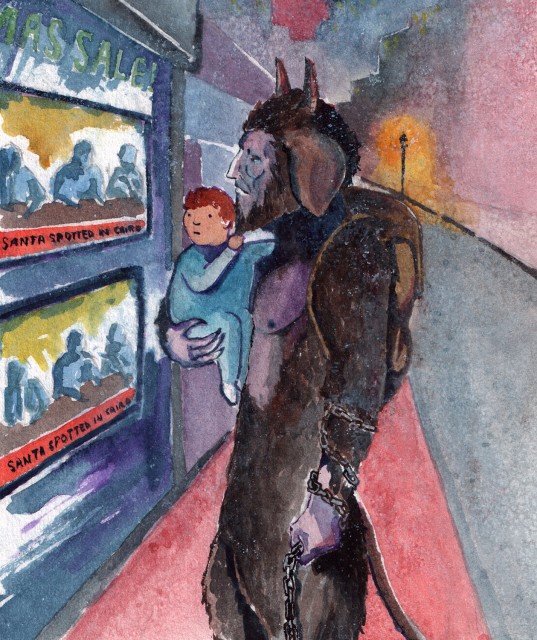How To Lie To Kids About Santa
How To Lie To Kids About Santa
by Christian Brown and Tully Mills

Now, I don’t think I ever actually believed in Santa. The closest I came was a slow-burning conviction that his name was Santa Sauce because he was, in some sense, actually a marinara-ladled meatball given life and laugh and beard. I don’t think that counts, really — certainly a meatball could never hold a sleigh’s reins, or operate a multinational corporation — so I’ll claim that I knew from day zero that Santa was, strictly speaking, a kind of lie.
But he’s a useful lie. One that parents can deploy to effectively trick children into not behaving like tiny sociopaths who are too short to drive themselves to school. (Imagine attempting to get full grown adults to act like goddamn humans who can be nice for once in their lives by telling them about a slave owner with a really fancy closed-circuit television system who watches them wherever they go.)
So what’s the best, most effective way to lie to your children about Santa and impress upon them his omniscience and power? Well, it depends on how old they are. And so herewith I have assembled for you a host of explanations of how best to trick your small child into good behavior, sorted by age. Bookmark this website, and let it guide you year after year as the tiny person grows ever larger and more pop-culture savvy.
LIES ABOUT SANTA APPROPRIATE FOR ALL MANNER OF SMALL HUMANS
AGE 0–2
Say whatever you want. Have you met a baby? Babies have no idea what you are saying. They don’t understand complex ideas like gifts or punishment or mens rea — you aren’t going to be able to affect their behavior at all, no matter what you do! Here, however, is where you can lay down some key words that you will use later. Even teeny tiny infants will pick up on sounds, and you can turn this to your advantage by laying down stories as a bedrock for your future deceits.
Example: Santa. Saaanta. Santa santa. North pole reindeer. Presents. *Mime of opening a tiny baby-sized present, wide-eyed delight on your face.* Elf santa claus santa. Good. Nice.
AGE 3–5
Your little human will now recognize actual sentences. The bad news is, you will have to pay attention to your stories to make sure they have things like “syntax” and “meaning.” The good news, you will be able to practice lying! A toddler is not very smart, so make sure your explanation is clear-cut, morally absolute, and does not rely on knowing about other famous myths. You’re aiming for Star Wars, not the Silmarillion.
Example: Santa Claus is a man with a beard who lives at the North Pole. The North Pole is a very cold snowy place, where it is winter all the time and there are no other people, just Santa and his family! He gets very bored there, so he watches little kids all around the rest of the world using his Santa Vision, and once a year he rides in a magic sleigh to deliver presents to all the little boys and girls who did not disappoint him. Be good, or he will never bring you a present until next year, which is a long time from now.
AGE 6–8
Some parenting experts call this age “The Learnsies,” when television and twitter teach kids how to more effectively yearn for consumer goods. You’ll often see commercials during children’s cartoon programs for things like toys and class action lawsuits and tiny designer handbags. Or, if you are reading this six to eight years in the future, you will see holocommercials during children’s braincasts for things like eye implants and hoverboards and nanoshoes. Now is the time to start using the increasing cultural literacy of your little one against it! Work in some branding or some of their favorite cartoon characters. Consider adding some animals, too. Kids love animals!

Example: Long ago, all cats hated all people. Even Garfield hated people. You see, cats and people could not speak the same language, and humans could not understand that cats just wanted a warm bed and a plate of lasagna. They would try to play fetch, or to sing songs to the cats, and the cats hated it. So they chose from among themselves one representative to go to the humans, to teach them what cats like (being nice, cleaning up after themselves, sleeping a whole lot during the day) by giving gifts to the kids who were most like cats. This hero cat groomed his whiskers into a beard, his hat ears into a hat, and took his name from his once-sharp claws (get it?). Even to this day, once a year, he rewards the nicest, most cat-respecting kids with whatever they most desire, as long as it’s not too expensive or big.
AGE 9–11
By this age, your kids will be expecting a little bit more from their backstories. Depending on their levels of nerdiness, they’ll be reading old Asimov books in the library or looking up footsketball player stats on Yahoo! Sports — either way, they’ll be looking for a more rounded and complete Santa portrait. You’ll need to add a dramatic arc, which you can use to explain his limitations without leaving your kid with too many doubts. A useful trick then is to link your Santa story to something your kid loves, like a unicorn or a robot or a placekicker.
Example: Sentient Automated Niceness-calculating Toy-delivering Automaton, or S.A.N.T.A., is a robot from space, the last of his kind, sent to Earth with only one directive: To manufacture as many presents as possible, and launch them across the planet with his powerful SANTACANNON — the only way, of course, to get all those toys to all those kids in a single night. Unfortunately, as time goes on his parts begin to wear down, and he cannot serve every boy and girl any more. He must choose who is most deserving of his finely calibrated presents, by careful observation of the naughtiest and nicest behavior throughout the year. Those children he deems unworthy receive only a single grease-stained sprocket.
AGE 12–14
By this point, your kid will be questioning everything you ever told them. Religion, morality, your ability to function in the world without their direction, even implausible mythical men who deliver gifts will be doubted. And let’s face it, at this point, your Santa story is showing some signs of age and probably looking a little threadbare. Solution? Introduce a villain, who can add zip and menace to the story while also serving as a plot device to fill in your story’s more tattered edges. Just don’t make him too charismatic — remember what happened with Spike on “Buffy”?

Example: Santa is the last of an ancient race of protomen — those who built Atlantis and Mu and Hyperborea. He uses his primeval wisdom, once harnessed to build those antediluvian civilizations (and the pyramids themselves) to atone for the gross excesses and sins of his people. He is haunted by the only remaining member of the slave caste, a creature named Krampus, who taunts Santa by teaching the poorest children that they do not need his presents to be happy. Ageless, deathless, cursed to redeem his people, he sends gifts to children around the world, hoping eventually he will be able to earn the right to die.
AGE 15 and up
At this point, your child is too old for Santa. If you’ve done a good job lying to them, they may ask you to keep coming up with increasingly elaborate explanations for their favorite bearded frost giant. Do not do it. This is called The Santamarillion Complex, and encouraging it will only lead to your kids writing fanfiction when they should be kissing other teenagers.
I hope this guide is of some small use to you over the years of tricks. Be sure to fancy these lies up and adapt them to your particular child’s preferences — for instance, if your child is afraid of goat-horned men, do NOT mention the horns Santa hides under his suspiciously large hat. Never let Santa be overtly threatening — just ominously withholding of his love, like God, or you. And above all else, remember to slip them some Nyquil on Christmas Eve so they don’t wake up while you’re still drunkenly stacking presents under the tree.
Christian Brown (text) is an animator in Los Angeles, but sometimes he’s gotta share mythopoetic Santa stories on the internet. Probably best not to ask him about the role of Tim Allen’s The Santa Clause on his childhood understanding of the holidays.
Tully Mills (art) is an illustrator living in San Francisco.
